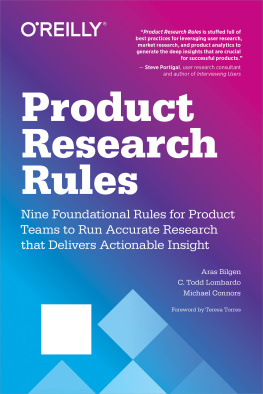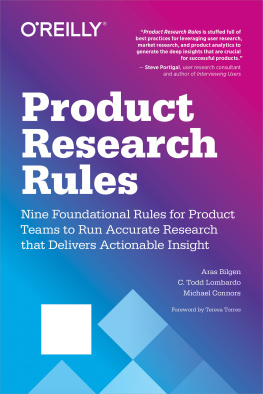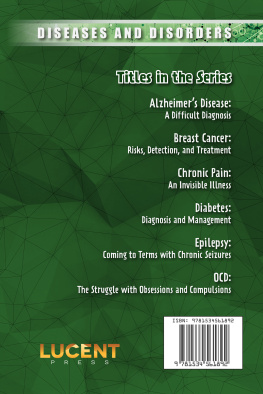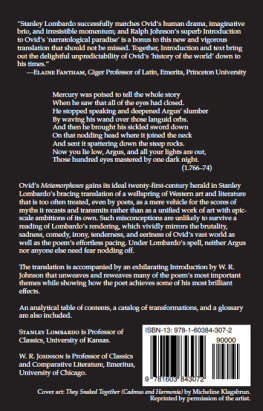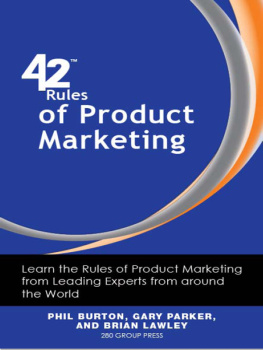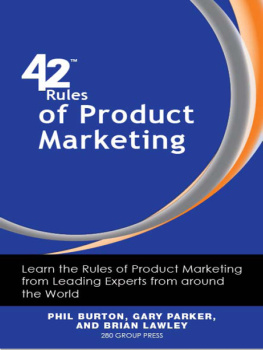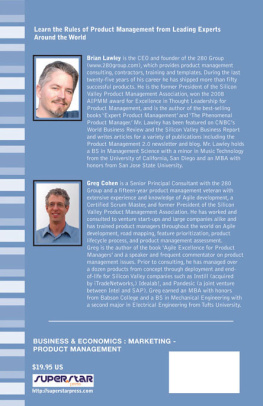C. Todd Lombardo - Product Research Rules
Here you can read online C. Todd Lombardo - Product Research Rules full text of the book (entire story) in english for free. Download pdf and epub, get meaning, cover and reviews about this ebook. year: 2020, publisher: OReilly Media, Inc., genre: Business. Description of the work, (preface) as well as reviews are available. Best literature library LitArk.com created for fans of good reading and offers a wide selection of genres:
Romance novel
Science fiction
Adventure
Detective
Science
History
Home and family
Prose
Art
Politics
Computer
Non-fiction
Religion
Business
Children
Humor
Choose a favorite category and find really read worthwhile books. Enjoy immersion in the world of imagination, feel the emotions of the characters or learn something new for yourself, make an fascinating discovery.
- Book:Product Research Rules
- Author:
- Publisher:OReilly Media, Inc.
- Genre:
- Year:2020
- Rating:3 / 5
- Favourites:Add to favourites
- Your mark:
- 60
- 1
- 2
- 3
- 4
- 5
Product Research Rules: summary, description and annotation
We offer to read an annotation, description, summary or preface (depends on what the author of the book "Product Research Rules" wrote himself). If you haven't found the necessary information about the book — write in the comments, we will try to find it.
C. Todd Lombardo: author's other books
Who wrote Product Research Rules? Find out the surname, the name of the author of the book and a list of all author's works by series.
Product Research Rules — read online for free the complete book (whole text) full work
Below is the text of the book, divided by pages. System saving the place of the last page read, allows you to conveniently read the book "Product Research Rules" online for free, without having to search again every time where you left off. Put a bookmark, and you can go to the page where you finished reading at any time.
Font size:
Interval:
Bookmark:

Product Research Rules
by Aras Bilgen, C. Todd Lombardo, and Michael Connors
Copyright 2021 C. Todd Lombardo, Aras Bilgen. All rights reserved.
Printed in the United States of America.
Published by OReilly Media, Inc., 1005 Gravenstein Highway North, Sebastopol, CA 95472.
OReilly books may be purchased for educational, business, or sales promotional use. Online editions are also available for most titles (.
Acquisitions Editor: Melissa Duffield
Development Editor: Sarah Gray
Production Editor: Katherine Tozer
Copyeditor: Shannon Turlington
Proofreader: Piper Editorial, LLC
Indexer: Potomac Indexing, LLC
Cover & Book Designer: Michael Connors
Illustrator: Michael Connors
November 2020: First Edition
Revision History for the First Edition:
2020-10-26First Release
See https://www.oreilly.com/catalog/errata.csp?isbn=0636920235590 for release details.
The OReilly logo is a registered trademark of OReilly Media, Inc. Product Research Rules and related trade dress are trademarks of OReilly Media, Inc.
Many of the designations used by manufacturers and sellers to distinguish their products are claimed as trademarks. Where those designations appear in this book, and OReilly Media, Inc. was aware of a trademark claim, the designations have been printed in caps or initial caps.
Although the publisher and author have used reasonable care in preparing this book, the information it contains is distributed as is and without warranties of any kind. This book is not intended as legal or financial advice, and not all of the recommendations may be suitable for your situation. Professional legal and financial advisors should be consulted, as needed. Neither the publisher nor the author shall be liable for any costs, expenses, or damages resulting from use of or reliance on the information contained in this book.
978-1-492-04947-0
[GP]
As product-discovery practices mature, product researchers are renewing their emphasis on evidence-based decision making. Product teams strive to be customer-centric, data-informed, and hypothesis-driven. They are adopting more rigorous methods to capture decision inputs, relying on customer interviews, prototype testing, and behavioral analysis to better understand their customers. They are investing in better measurement techniques like split testing, monitoring traction metrics, and tracking cohorts over time to better understand the impact of what they are building.
As we see the popularity of these new research methods grow, we are also seeing wide variation in the level of success product teams are having with adopting and getting value from research. Few teams have members who are trained as scientists or in research methods. As a result, we see teams follow best practices outlined in blog posts or conference talks without a deep understanding of why or how these methods work. We see an overreliance on testing tools to do the scientific thinking for us. Most teams are following recipes rather than matching the right research method to their specific task.
Some product teams are supported by user researchers, data scientists, or business intelligence teams. In some companies, product teams farm out their research to these centralized teams and receive a research report in response. But its hard to act on research reports that are often generated on a different work cadence. Centralized teams often support many teams and have little bandwidth. A product teams research needs change week to week as they learn whats working and whats not. In other companies, these centralized research teams act as subject matter experts, advising product teams on how to conduct their own research. This can work well if the teams have the bandwidth to meet demand, but that is rarely the case in practice.
A truly empowered, cross-functional, autonomous product team cant thrive without research skills. Most companies are already resource constrained and cant hire specifically for this role. Instead, they need a way to quickly level up the research skills of the folks who are already on these cross-functional product teams and help them adopt an experimental mindset. We need to equip those who are eager and willing to learn by investing in their research skills. This book is a great place for them to start.
TERESA TORRES, 2020
Product research doesnt have to be difficult. It doesnt have to take a long time and cost a lot of money. It doesnt have to be done by scientists or expert researchers. It can be quick, cheap, and simple, and the whole team can do it. You just have to remember a few rules and develop a research mindset.
We started this journey with a question: why, in an industry that has been building digital products for decades, do teams still make products that fail? Article after article came up with credible answers: myopic vision, lack of market fit, no differentiation, poor focus, inability to cross the chasm, too many negative reviews, and more. But at the root of all of these is one problem: failing to understand the needs of the customer.
When teams want to understand their customers, they turn to market and user research. Market research is collecting and analyzing information about a market that is categorized by the products or services sold within it. It encompasses the characteristics, spending habits, locations, and needs of a businesss target market and the industry as a whole. User research identifies the users goals, needs, and motivations using human-centric methods.
While both market research and user research create great insights, what many teams fail to do is build on these insights in a timely manner. By treating research as a special, untouchable project that only a handful of people conduct on an infrequent basis, they miss out on leveraging their findings in the actual making of the product. The outcome is frustration, poor understanding of the market, and a product that isnt designed for its user.
Sometimes valuable qualitative data can get overlooked because there arent concrete hard numbers in qualitative research. Numbers matter, although its not all numbers. It is unfortunate that many executives dont know how to deal with qualitative research. Instead, they rely on what makes the most sense to them: the numbers. Its important to realize that in product research, numbers do matter, just as much as the stories, anecdotes, and observations that lead to insights.
Product research is an approach that draws from user research, market research, and product analytics to help any product team arrive at insights in a timely, continuous manner (see ).
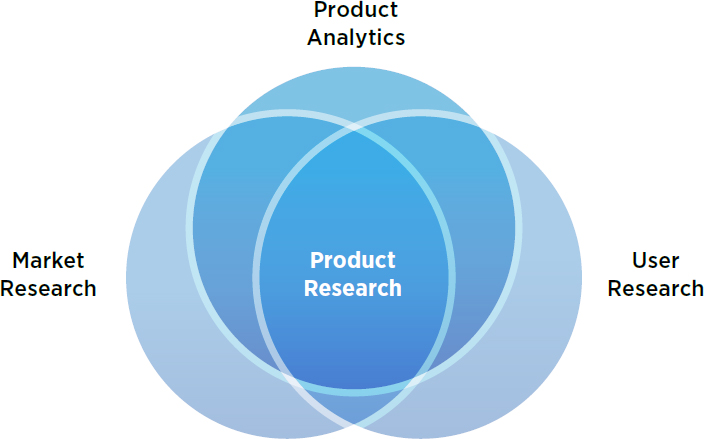
If you dont have good data, your conclusions and insights can lead you astray. Well show you how to look at all three types of input to connect the dots for smart insights that can lead you to build great products.
Some consider product research to be a waste of time and resources, and if youre one of these people, were so glad youre here. This is often because the research is conducted poorly with inconsistent results that lack real insights. Product research draws on the strengths of both market and user research and focuses on understanding how your product works for the users it serves. It uses product analytics to inform research questions and relies on behavioral evidence to understand the user. Product research acknowledges the existence of a market and always considers market dynamics when interpreting results and suggesting actions.
Font size:
Interval:
Bookmark:
Similar books «Product Research Rules»
Look at similar books to Product Research Rules. We have selected literature similar in name and meaning in the hope of providing readers with more options to find new, interesting, not yet read works.
Discussion, reviews of the book Product Research Rules and just readers' own opinions. Leave your comments, write what you think about the work, its meaning or the main characters. Specify what exactly you liked and what you didn't like, and why you think so.

